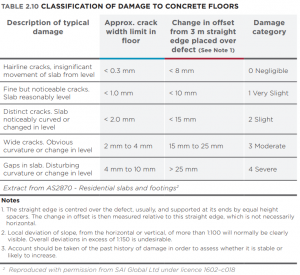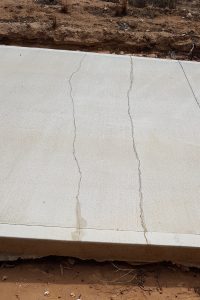Concrete Cracking Part 1: Settlement & How much is too much?
This is the first of our three-part series on concrete cracking, more information can further be found in;
Part 2: Shrinkage & Thermal Behaviour
Part 3: How can it be reduced?
Concrete will always crack at least a little bit as it’s setting, there is no way to avoid cracking completely, and cracks occurring are not always attributable to unsatisfactory workmanship. There are reasons that cracking can become much more evident and if too much occurs it can affect the integrity of the structure.
How do these Cracks Occur?
The strength of the slab is dependent on the strength of the soil. For example, if fill is being used on site, it needs to be compacted properly, otherwise, settlement can cause the slab to move and crack as well.
Another example and one of the most common reasons, especially in Adelaide, for cracking occurring is due to the heave of the soil and seasonal weather conditions. To start with clay soils, need to be at a high moisture content BEFORE concrete is cast on top. Otherwise, the soil will suck the moisture from the concrete, causing the soil to swell and push on the slab and crack it. On top of this, the moisture being removed from the concrete can cause issues as well as talked about more in our concrete curing blog.
Other influences that can decrease the strength and integrity of the soil, therefore affecting concrete slabs includes over-watering lawns, which causes soils to weaken. Along with seasonal temperature changes that cause the soils to swell in winter and shrink in summer. These changes in soil stability can cause the slabs to move, and while there are a few other sources of concrete movement, these are the main causes that houses sink, causing their walls to crack.
So just how much is too much?
While there are no standards for the acceptable number of cracks in concrete structures, Australia does have some standards when it comes to deciding if the cracks are from defects or not. For the most part, if the cracks are less than 1.5mm in width and the length is less than those specified in Australian Standards (generally ranging from 5mm to 15mm) then it can be assumed to be minor cracking that is acceptable. An example of this can be seen in the extracted table provided below by Queensland Building & Construction Commission.

But what about having too many ‘acceptable’ cracks? This is something that there aren’t standards for and is determined on a case by case basis, depending on who is analysing the concrete. Where one person may think the cracking is unacceptable and needs fixing through one way or another, another may look at it and believe that it the amount of cracking is fine. Of course, if large cracks are occurring then more than likely it’s going to need some amount of work to repair.
If you’re unsure whether your property needs repairing due to cracking or not, you should call us at Epic Projects & Consulting to have it inspected by a professional structural engineer.
Resources
https://www.youtube.com/watch?v=gkG_a60IvOE
https://www.qbcc.qld.gov.au/sites/default/files/Standards_and_Tolerances_Guide_0.pdf

